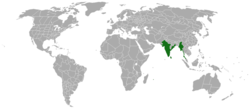| Senegalia chundra | |
|---|---|
 | |
| Scientific classification | |
| Kingdom: | Plantae |
| Clade: | Tracheophytes |
| Clade: | Angiosperms |
| Clade: | Eudicots |
| Clade: | Rosids |
| Order: | Fabales |
| Family: | Fabaceae |
| Subfamily: | Caesalpinioideae |
| Clade: | Mimosoid clade |
| Genus: | Senegalia |
| Species: | S. chundra |
| Binomial name | |
| Senegalia chundra | |
 | |
| Range of Senegalia chundra | |
| Synonyms [1] | |
Senegalia chundra is a perennial, deciduous tree found in Asia, India and in the Indian Ocean area. It grows 12 to 15 metres in height. [2]
Contents
Common names for it include karangali, kodalimurunkai, lal khair, lal khair, rat kihiriya and red cutch.
Its uses include chemical and wood products.